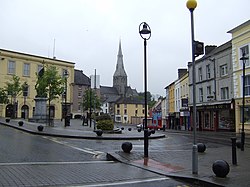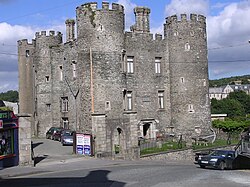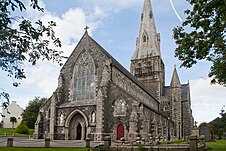Difference between revisions of "Enniscorthy"
m |
m (clean up) |
||
| Line 38: | Line 38: | ||
===St Aidan's Cathedral=== | ===St Aidan's Cathedral=== | ||
[[File:St. Aidan's Cathedral Enniscorthy SE 2009 09 28.jpg|right|thumb|226px|Saint Aidan's Cathedral, Enniscorthy]] | [[File:St. Aidan's Cathedral Enniscorthy SE 2009 09 28.jpg|right|thumb|226px|Saint Aidan's Cathedral, Enniscorthy]] | ||
| − | Following the relaxation of the Penal Laws at the beginning of the 19th century, it became possible for the Roman Catholic community to consider building a cathedral. Built in 1843, St Aidan's Cathedral,<ref>[http://www.puginireland.com St | + | Following the relaxation of the Penal Laws at the beginning of the 19th century, it became possible for the Roman Catholic community to consider building a cathedral. Built in 1843, St Aidan's Cathedral,<ref>[http://www.puginireland.com St Aidan's Cathedral]</ref> was designed by Augustus Welby Pugin, an architect most famous for the [[Palace of Westminster]]. The cathedral is in the same Neo-Gothic style. Notable features include the striking façade, a reredos carved from Caen stone and a great north window with intricate stone tracery. The cathedral was subsequently much renovated (in line with reforms promulgated by the second Vatican Council). It was restored to its near original design in 1994 when authentic colours, materials and techniques were used. The restoration took a year, during which time cathedral services were held at St Mary's church (Church of Ireland) nearby. |
===1916 Rising=== | ===1916 Rising=== | ||
Latest revision as of 12:42, 2 August 2017
| Enniscorthy Irish: Inis Córthaidh | |
| County Wexford | |
|---|---|
 Enniscorthy town centre | |
| Location | |
| Grid reference: | S969399 |
| Location: | 52°30’7"N, 6°33’57"W |
| Data | |
| Population: | 10,838 (2011) |
| Post town: | Enniscorthy |
| Postcode: | Y21 |
| Local Government | |
| Council: | Wexford |
Enniscorthy is the second-largest town in County Wexford, Ireland. At the 2011 census, the population of the town and environs is 10,838.
The origins of the town's name are obscure. It may refer either to the "Island of Corthaidh" or the "Island of Rocks". With a history going back to 465, Enniscorthy is one of the longest continuously-occupied sites in Ireland. The cathedral of the Roman Catholic Diocese of Ferns is located in the town.
Contents
History
Enniscorthy Castle
Enniscorthy Castle is an imposing Norman stronghold, which dates from 1205 and was a private dwelling until 1951. The castle was built by the DePrendergasts. In the early 1580s the poet Edmund Spenser leased the property that included the castle.[1]
The castle was also once owned by Sir Henry Wallop. The castle was the site of many fierce battles during the Cromwellian years and also the 1798 Rising. The castle houses the Wexford County Museum, which contains extensive 1798 rebellion-related material, as well as items of local and agricultural interest. It was closed for major refurbishment from 2007 until May 2011.
Vinegar Hill
Vinegar Hill (Irish: Cnoc Fhiodh na gCaor, which translates as 'hill of the berry-tree'), a pudding-shaped hill overlooking the town, was the largest camp and headquarters of the rebels of 1798 who controlled County Wexford for thirty days against vastly superior forces, before their defeat at the Battle of Vinegar Hill on 21 June. However, many managed to flee south through a gap left in the British lines by General Needham (now known as Needham's Gap). During this time, Beauchamp Bagnell Harvey was declared President of the Wexford Republic.
The 1798 Visitor Centre (Áras 1798)
The 1798 Visitor Centre is devoted to the history and aftermath of the 1798 Rising setting it in its European context. It is housed in the former Congregation of Christian Brothers monastery.[2] The Visitor Centre offers people the chance to see what famous figures were involved in the 1798 Rising.
St Aidan's Cathedral
Following the relaxation of the Penal Laws at the beginning of the 19th century, it became possible for the Roman Catholic community to consider building a cathedral. Built in 1843, St Aidan's Cathedral,[3] was designed by Augustus Welby Pugin, an architect most famous for the Palace of Westminster. The cathedral is in the same Neo-Gothic style. Notable features include the striking façade, a reredos carved from Caen stone and a great north window with intricate stone tracery. The cathedral was subsequently much renovated (in line with reforms promulgated by the second Vatican Council). It was restored to its near original design in 1994 when authentic colours, materials and techniques were used. The restoration took a year, during which time cathedral services were held at St Mary's church (Church of Ireland) nearby.
1916 Rising
In 1916, at the time of the Easter Rising, James Connolly requested that the Enniscorthy Volunteers take and hold the railway line to prevent reinforcements from reaching Dublin. In response, 600 Volunteers took the town, led by Robert Brennan, Seamus Doyle and J R Etchingham, they surrounded the police station, but did not attempt to take it. The RIC barracks was held by a police inspector and five constables while an RIC sergeant and one constable prevented the rebels from taking over a bank in the town. They established headquarters at the Athenaeum, and held control until asked to surrender by Padraig Pearse.
The Volunteers also established a strong position on Vinegar Hill, overlooking the town. The railway line was cut and men dispatched to Gorey and Ferns. The government responded by sending a force of more than 1,000 men to retake Enniscorthy and the rebels retired to their positions on Vinegar Hill. Before hostilities could develop the news of the Dublin surrender arrived, but the Volunteers refused to believe it. The army commander, Col FA French, to avoid bloodshed, offered safe conduct for the Wexford leaders so that they could go to Dublin and hear of the surrender directly from Pearse. There were no fatalities.
About the town
Churches
Enniscorthy is the cathedral town of the Roman Catholic Diocese of Ferns.
- Church of Ireland: St Mary's
- Methodist / Presbyterian: Enniscorthy Presbyterian Church
- Non-denominational: Alive Church
- Society of Friends (Quakers): meeting hall
- Roman Catholic
- St Aidan's Cathedral
- St Senan's
Amenities
Enniscorthy stands by the River Slaney, and has short walks beside it to the north and to the south, on the west bank.
There is a swimming pool/recreation centre, several sports grounds including a rugby club and GAA club and several hotels including the four star Riverside Park Hotel. Surrounding the town, there is an 18-hole golf course, several pitch and putts, freshwater fishing, and a five-star spa Monart is just beside "The Still Pond". The town also boasts several historical sites and museums. Young people complain about the general lack of amenities for them to use. Plans for a skate park were put forward but these were rejected as the town council deemed there was no funding available. Festivals:
- The Strawberry Fair, an annual event held in the last week of June. It consists of amusements in Bellfield, live bands and the crowning of the Strawberry Queen in the square.
- Blackstairs Blues festival, an annual event. The festival includes international and local performers, in a variety of late night concerts and open workshops. The festival includes a free pub trail and late night festival club.
- Enniscorthy Street Rhythms and Dance Festival, an annual event held in August. The Festival includes dance exhibitions, parade, fireworks, concert and dance workshops.
The town in literature
Enniscorthy is mentioned in the Ithaca chapter of James Joyce's Ulysses as a flyleaf note in a book belonging to Leopold Bloom, where it is described as "Ennifcorthy, County Wicklow, the finest place in the world".
Commerce
Davies Distillery
As early as 1824 Francis Davies, a Miller, operated a Spirit business from his mill in Enniscorthy.[4] Davies then employed John Mullaly as distiller. Mullaly had previously worked as a distiller with John McKenzie & Co in Mill Street Belfast. When Theobald Mathew (temperance reformer) preached temperance, many distilleries in Ireland closed.[5] After the Davies distillery closed, Mullaly and his family cast their lots together and emigrated to Australia on the Salsette in 1840.[6]
George Killian's Red
Enniscorthy was the location of a regional microbrewery opened in 1864 and owned by the descendants of George Killian Lett. During their operation Killian's ale was sold almost entirely in Wexford county. Lett's Brewery still operates today, but no longer brews its own products. They now focus on wholesale to shops, bars and hotels.[7] Killian's Red is still sold abroad, and the brand is currently held by Brasseries Pelforth, S. A.
Pottery
Carley's Bridge Pottery is one of Ireland's oldest potteries, having made earthen pots for over three hundred years. Paddy Murphy was also an Enniscorthy potter and in 1980 founded Hill View pottery adjacent to his home and close to Carley's Bridge Pottery. The cul de sac "Potters' Way" is named after for him — as he would walk that route to his home. Since his passing, Hill View pottery has been taken over by his relation Derek O'Rourke.
Enterprise Centre
Enniscorthy Enterprise & Technology Centre the home of business support and training for small and medium enterprises. The centre specialises in the support of start-up businesses and the upskilling of people in employment in Co. Wexford. The difference between an Enterprise centre and other enterprise units are the services. It not only rents a space, but it is part of the structure that promotes and supports a business. The environment and facilities are created to help businesses and also promote a professional image to their clients.
Outside links
| ("Wikimedia Commons" has material about Enniscorthy) |
References
- ↑ Oxford DNB
- ↑ Visitor Centre
- ↑ St Aidan's Cathedral
- ↑ [1] Piggots Directory 1824
- ↑ Father Mathew a Biography – John Francis MacGuire (Longman Green, Longman, Roberts and Green Lon 1863
- ↑ [2] Passenger list Salsette
- ↑ Gofree.indigo.ie, Lett's Website




